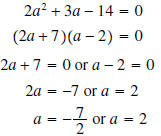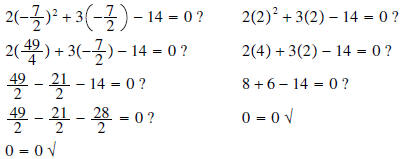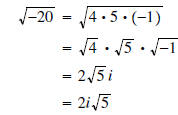Solving Quadratic Equations
A quadratic equation is an equation that can be written in
the form

This is referred to as the standard form of a quadratic
equation. We will discuss three methods for solving
quadratic equations: factoring, completing the square, and using the quadratic
formula.
I. Solving by Factoring
The following theorem is the basis for solving equations
by factoring :
Theorem: If ab = 0, then a = 0 or b = 0 or both.
Therefore, the following strategy can be applied to solve
equations by factoring:
1. Write the equation in standard form (if it is not
already in standard form)
2. Factor
3. Set each factor equal to zero and solve.
Example 1: Solve 
Solution: We first write the equation in standard form:
 subtract 5x from both sides
subtract 5x from both sides

 add 6 to both sides
add 6 to both sides

 now factor the left
now factor the left
 set each factor equal to 0 and solve
set each factor equal to 0 and solve

We can check both of our solutions:

Both 2 and 3 are solutions.
Example 2: Solve

Solution: The equation is already in standard form, so
factor and solve:

We can check both of our solutions:

Therefore, both
 and 2 are solutions to the equation .
and 2 are solutions to the equation .
II. Solving by Completing the Square
The equation x2 = 9 can easily be solved by knowing that
32 = 9 (so x must be 3). However, there is another
number whose square is 9. Recall that the product of two negative numbers is a
positive number. Thus
x = -3 is also a solution to the equation since

In general, the solution to the equation x2 = c (where c
is positive) is
 or
or
 .
This can be written
.
This can be written
more concisely as This method is often referred to as the square root extration method or simply
the
This method is often referred to as the square root extration method or simply
the
square root method.
Example 3: Solve each of the following equations.

Solution:
a) The solution is given by (remember to simplify your
radicals!)

b) Note that if

then

or (adding 2 to both sides)

Given a quadratic equation
 (especially one which is not easily factored), we can rewrite the
(especially one which is not easily factored), we can rewrite the
equation so that the left-hand side is a perfect square (like the second example
above). The process, which
works on every quadratic expression, is described below:
Example 4: Solve
 by completing the square
by completing the square
Solution 1: We begin by arranging the left-hand side to look like

 subtract 3 from both sides
subtract 3 from both sides

Now we half and square the linear coefficient (the number
in front of y) and add this number to BOTH sides of
the equation:
 add
add
 to both sides
to both sides
 get
a common denominator on right
get
a common denominator on right
 add
the numerators on right
add
the numerators on right

Why did we do this? Because the left-hand side is now a
perfect square. Recall the special product

Notice that if we take one-half the coefficient of x and
square it, we obtain

This will work no matter what a is.
Since the left hand side is a perfect square we can ”undo”
the square by taking the square root of both sides.
 “factor”
the left
“factor”
the left
 now
solve as example 2 above
now
solve as example 2 above
 simplify
the radical
simplify
the radical
 subtract
7/2 from both sides
subtract
7/2 from both sides
 final
solution
final
solution
Solution 2: Later it will be more useful when completing
the square to organize our numbers as follows:

From here, we add 37/4 to both sides and continue as
before.
Example 5: Solve
 by completing the square.
by completing the square.
Solution 1: Since the coefficient of x2 is not 1, we have
to be more careful when writing the left-hand
side as

 subtract
1 from both sides
subtract
1 from both sides
 divide both sides by 9
divide both sides by 9
 half
and square
half
and square

 common
denominator on right
common
denominator on right
 factor
left side (perfect square)
factor
left side (perfect square)
 solve
using square roots
solve
using square roots
 subtract
5/9 from both sides
subtract
5/9 from both sides


Solution 2: You must also be extremely careful if you use
the alternate method of completing the square
here:

Then proceed as above.
Question: Why
 in
step 3?
in
step 3?
Answer: We added the 5/9 inside the parentheses, so the 9
distributes over it:

so we have actually added
 to our expression. To balance this, we must subtract
to our expression. To balance this, we must subtract
 from
the
from
the
same side or add it to the other side.
III. Solving with the Quadratic Formula
We can use the technique of completing the square on the
general quadratic equation
 to
to
derive a general formula for the solutions to a quadratic equation:
 |
subtract c from both sides |
 |
divide both sides by a |
 |
half and square
 |
 |
get a common denominator on right |
 |
add numerators |
 |
factor left side |
 |
use square root method |
 |
simplify radical |
 |
subtract b/2a from both sides |
 |
combine common denominator fractions |
 |
|
The final step gives us the Quadratic Formula.
The solution to any quadratic equation of the form

is given by

This formula must be memorized.
Remember: a is the coefficient of x2, b is the
coefficient of x, and c is the constant term in this formula.
Example 6: Solve
 using the Quadratic Formula
using the Quadratic Formula
Solution: For the quadratic formula a = 1, b = 7, and c = 3.
 substitute
in formula
substitute
in formula

 .
Thus, we have
.
Thus, we have

Example 7: Solve
 using any method.
using any method.
olution: First write the equation in standard form. The
quadratic formula is generally the easiest
method to use when the quadratic does not easily factor.

For the quadratic formula,
 (be careful with signs ), and c = 1.
(be careful with signs ), and c = 1.

 simplify
the complex radical (*See Note Below)
simplify
the complex radical (*See Note Below)
 now
factor and cancel the common 2
now
factor and cancel the common 2

Note that the solutions above are complex numbers. Be sure
to simplify any radicals in your final solutions!
*Note: In simplifying the complex radical, recall that

So




